Volleyball exercises for u19
- Team 1(balls) get 10 balls to serve with.
- If a ball is passed
- and is caught on the half where it is passed,
- If the ball is hit into the net, it is taken out of play.
- also if it is served out,
- or is served into the net,
- it goes out of play.
- The team that serves the most wins.
Team 1(balls) get 10 balls to serve with. If a ball is passed and is caught on the half where it is passed, then this ball is taken out of play. Also if it is served out, or in the net, then this ball goes out of play. The team that serves the most wins.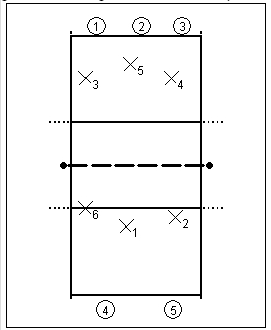 |
Training rhythm and cadence for the playmaker.
Explanation of the exercise:
This exercise is useful for playmakers who want to get rhythm and cadence in their set-ups. In this way, the playmakers get a lot of ball contact and can set-up a lot.
The outfielder passes. The centre, preferably three, comes in from the left, hits the ball and turns it in again on the right. The next one is on the right, goes to the left, etc. These players, seen from above, turn 8s. The coach brings in the balls and can set the pace.
Of course, you can later have the middle players pass and go out and rock. By first coming in from the left, then from the right Of course, later on the centre can pass and the outfield player can rock by coming in first from the left and then from the right.
Duration of the exercise:
10-15 min
An exercise for the attacker. The attacker has to be available for a second attack after a block.
First the middle attackers. At the net stand the playmaker (S) and a head blocker (1) ready to start blocking. Next to them stands the trainer (T) with a ball. Three defenders (4, 5 and 6) are standing at the back of the court.
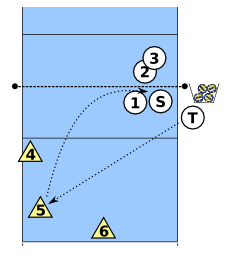
- The trainer hits the ball, and 1 and S block together.
- During the block the trainer smashes the ball to 4, 5 or 6.
- As soon as 1 is on the ground again after the block, 1 moves backwards for the attack run.
- 4, 5 or 6 defend the ball.
- S gives a setup to 1.
- 1 smashes the ball
- 1 retrieves the ball.
- 2 takes the place of 1 (1,2 and 3 rotate)
Then the outside attackers who for a change will attack on the right. The playmaker (S) stands in the middle and the outfielder (1) stands on the right. Next to them again the trainer (T) and in the field the defenders (4, 5 and 6).
- The trainer hits the ball, whereupon 1 and S block together.
- During the block the trainer smashes the ball to 4, 5 or 6.
- As soon as 1 is on the ground again after the block, 1 moves backwards for the attack run.
- 4, 5 or 6 defend the ball.
- S gives a setup backwards to 1.
- 1 smashes the ball
- 1 retrieves the ball.
- 2 takes the place of 1 (1,2 and 3 rotate)
| Passer/Looper and Diagonal on position 45 throws ball to 1, 2 moves from the net, 3 sets the block diagonally, 4 defends. SV has to put the ball past the blocker, giving attacker a chance to hit behind the block. 5 balls through. Middens should block when the ball goes over the net and then move left and back. SV must also move 2-3 metres to the left. Always offer as a centre and SV must always move. |
Set-up tips from coach Donnie!
In pairs first play fanatically.
After that:
- 2 pairs and move
- 1 plays overhand to 2
- 2 plays back overhand and moves alternately 3 meters to the left or right
- left or right and goes back to the starting position.
- 1 plays the returned ball directly left or right of 2.
- change after 2 minutes
- VARIATION: 2plays overhand
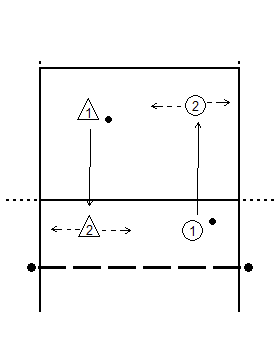
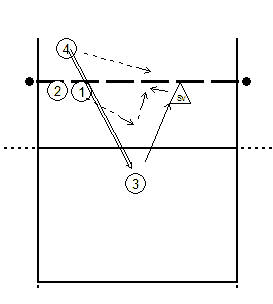
- 4 attacks calmly on 3 over the block of 1 and 2
- 3 pass to SV
- 1 turns around after the block and attacks the middle.
- 4 blocks
- 2 and 3 attacking.
- Variation: same on left ; same on right.
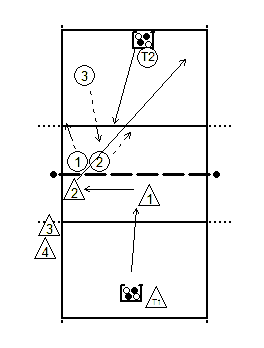
- T1 plays to playmaker 1
- set-up for 2-attack left
- 1+2 blocks, then back for attack
- T2 plays the ball to playmaker 3 who comes in from the right back
- set-up to 2 at the centre or to 1 at right front
- VARIATION: Idem: at left front
These exercises are done in pairs.
- Exercise 1:
- Person 1 stands with a ball near the net, person 2 stands to the left of the pole. Person 1 throws the ball to the left or right. Person 2 walks around the pole every time. 10 times per person.
- Exercise 2:
- Person 1 stands with a ball at net net, person 2 starts at the 3-meter line. Person 1 hits the ball and person 2 has to run backwards and play the ball to person 1 again. 10x per person.
- Exercise 3:
- Person 1 stands on the 3-meter line with a ball. Person 2 is going to block at the net and then turn around to play the short ball of person 1. 10x per person.
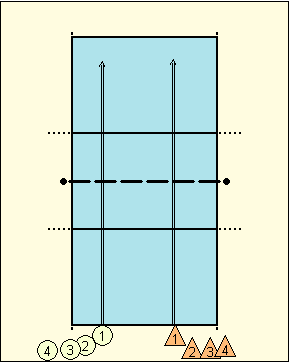
This exercise is fun to do and gives a lot of fun and competition! Relays in general already create competition.
What this exercise also wants to mimic is the stress factor that a serve brings.
The players are divided into equal teams and lined up on the serving area of the same court. The first player of a team serves and retrieves his ball. After the next player is tapped, this one serves, and so on.
It is important for a player to serve quickly, but it must also be flawless, otherwise the ball must be retrieved and served again!
If the teams are small, it is fun to let everyone serve two or three times.
Necessary:
- A minimum of 6 players
- As many balls as there are teams
Click here for the meaning of the symbols.
- The trainer stands on a box at the other side of the net, and the players must try to block the ball one by one.
- Step 1 is to explain when and why we block.








